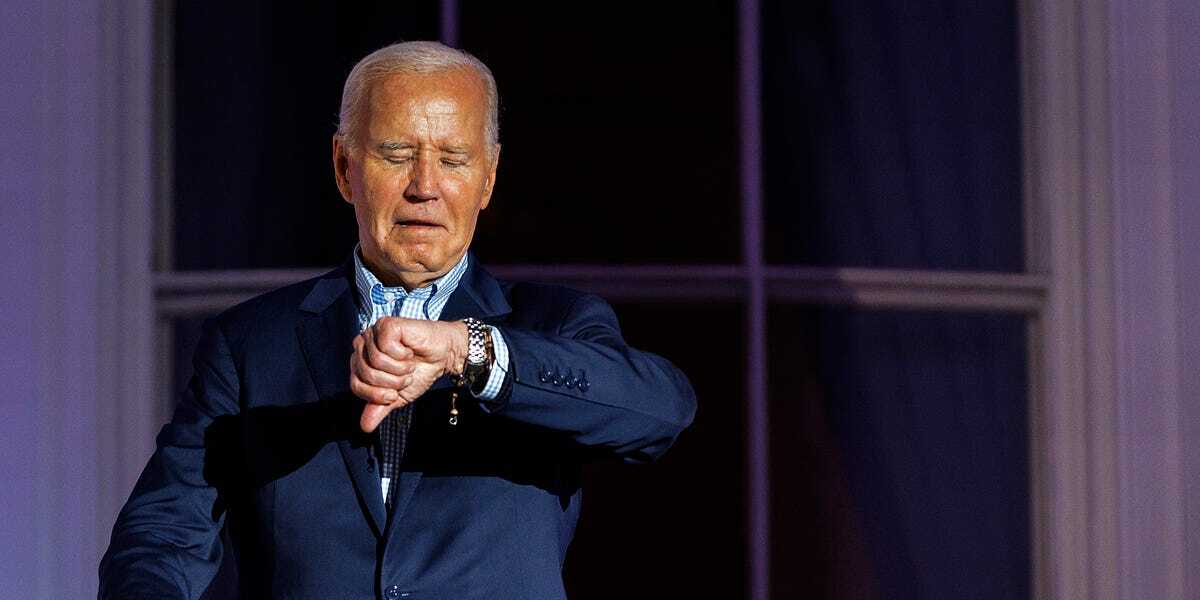Hard paywall.
I was admonished early in my reporting career by William Shawn, the famed editor of the New Yorker for thirty-six years, to “use words” instead of cliches, and always try to do so. But it is time to talk about the foreign policy elephants in the room in the current crisis over Joe Biden’s political future, which is also the immediate future of the fractious Democratic Party.
And they are the current disasters in Ukraine, where a reviled Vladimir Putin, the Russian president, is winning, and in Gaza, where Benjamin Netanyahu, the Israeli prime minister, is losing a murderous war with Hamas and the respect of much of the world. Joe Biden’s policies in both instances have been both a political and a humanitarian disaster.
Biden and his foreign policy gaggle, led by Antony Blinken, his secretary of state, and Jake Sullivan, the national security adviser, helped to provoke a war in Ukraine and have supported Netanyahu with words and a lot of American bombs and other weaponry in his decision to respond to the Hamas assault last fall with an all-out war against Hamas that has devastated the innocent civilian population of Gaza.
Yes, Putin initiated the war in Ukraine, but there are many in the foreign policy world here and in Europe who believed that he might not have done so had the White House earlier authorized Blinken to assure Putin that Ukraine would not become a member of the North Atlantic Treaty Organization. NATO begins a seventy-fifth anniversary meeting today in Washington and, according to a predictable announcement to the press, it “will focus on ways to reassure Ukraine of NATO’s enduring support.”
Despite some early losses, Russia, with its advantage in air and ground forces, is now dominating the war and, despite scant interest in Washington, there are serious peace talks going on. A senior American official told me that Putin “has what he wants” in Ukraine and delayed an all-out assault on Kharkiv, Ukraine’s second-largest city, while a possible settlement is being negotiated, with no known direct involvement of the crisis-ridden White House.
It also is not clear what the future holds for Volodymyr Zelensky, the reportedly dispirited president of Ukraine. “No one knows what is going to happen to Zelensky,” the official told me. “The chain for him is getting shorter by the day.” Constant Russian attacks on power stations have left urban areas throughout the country, including Kiev, with only a few hours of power a day—not enough to prevent refrigerated food from going sour. Russia began targeting energy facilities throughout Ukraine in March, according to Reuters; the projected cost of repair and replacement is, as of late June, more than $16 billion. Russia escalated its missile attacks yesterday on cities across Ukraine, with one missile striking a major children’s hospital in Kiev, killing at least thirty-six people and injuring 140 others. It was not immediately known how many victims were children.
The political situation in Israel is equally grim, as the Israeli government—still being supplied daily by the Biden administration with American 2,000-pound bombs—continues to pound away in its more and more unsuccessful war against Hamas. The IDF was unable on October 7 to prevent Hamas from seizing hundreds of hostages. The mood of anxiety and fear has darkened, increasing Netanyahu’s political hold on many with his insistence that Israel will stay in Gaza until victory over Hamas is achieved.
It has been a tour de force for Netanyahu, given the clear evidence that Israel has not come close to winning the war against Hamas, despite constant bombing and tank shelling and promises of victory. Most recently, the IDF staged a massive attack in what was said to be a tunnel complex in Gaza’s south, allegedly the last redoubt of Yahya Sinwar, the military leader of Hamas who is widely believed to be the mastermind of last year’s attack. At least two battalions were sent late in May into the tunnel complex, accompanied by sapper units whose soldiers had special training in the use of explosives.
The operation produced no sign of Sinwar nor any hostages, and no accounting of combat deaths or injuries was forthcoming from the IDF or the prime minister’s office. Ceasefire talks between Israel and the Hamas leadership have been going on, fitfully, for months—most recently in Cairo—with the involvement at various times of Blinken, Sullivan, and William Burns, the CIA director, but there has been no sign of an agreement. The American official with whom I’ve discussed the negotiations has consistently explained that it is his belief that Netanyahu will never agree to a release of prisoners in return for an Israeli retreat from Gaza because that would be a defeat, leaving Hamas still in control.
The number of Israeli prisoners officially reported to be in Hamas’s custody is 116, while fifty hostages reportedly died, or were killed, while in captivity. In my reporting, I have found consistent skepticism about those numbers. There are knowledgeable Americans who believe that only very few hostages who were in the Hamas tunnel system have survived, but do not know how many hostages may have been placed in Hamas and civilian apartments and homes throughout Gaza.
Two days ago the New York Times depicted the issue in simple terms. Netanyahu has “vowed to destroy Hamas and topple its rule” in Gaza, the paper said, and Hamas “hopes that a permanent cease-fire will allow it to cling to power.”
Meanwhile, the Israeli bombing and ground assaults continue, as Hamas has not only survived the onslaught but is known to control much of the flow of food and other goods into Gaza. Corruption continues to be rampant, as Hamas and smugglers constantly appropriate the relief goods and either sell the goods themselves or deliver them to black market operators throughout Gaza.
The number of deaths in Gaza from the Israeli bombings and other attacks was officially listed as of mid-June by the Gaza Health Ministry at more than 37,000, with a significant percentage of those being members of Hamas. I reported this two weeks ago and noted that the actual number of deaths is impossible to estimate, given that many of the Gazans who did the counting have been slain by Israeli bombing.
On July 5, The Lancet, a 200-year-old medical journal published weekly in London, published an online research paper—it did not go through peer review—stating that the number of indirect deaths per reported deaths in a combat zone such as in Gaza could be as much as four to one, meaning that the actual death total in Gaza could reach as many as 186,000 deaths, or up to 9 percent of the population.
I asked an old Israeli friend, with many combat medals, who has operational knowledge of what has been going inside Gaza, why Israel, with all of its bombs and tanks, has not been able to win the war. He spoke like the battlefield commander he once was. “The IDF,” he said, “has destroyed Hamas’s military structure and pushed them back to be the rag-and-sandals terror band they were before. Their supply line from Iran to Egypt” via 30 tunnels under Gaza “was cut” by IDF bombings and ground attacks. Despite that, he added, the Hamas “underground city” remains to some extent operational.
The real issue, he said, was that the Hamas leadership—mainly Sinwar—and the Israeli leadership—mainly Bibi—share at least one thing in common: “Not caring for their people” but “only caring for their own political survival. For this reason, Bibi will not allow the proposed hostage deal to materialize as then he loses his coalition. Bibi succeeded, and I give him credit for this, to turn the hostage issue into a political issue rather than a moral and humanitarian issue, and painted all supporters of such as leftists, the worst curse nowadays here.
“No matter what Bibi does,” the retired officer added, “we were defeated by a rag band mainly because of built-in ignorance and [note cut] arrogance.”
Whatever the end result, the driving force in the recent round of negotiations between Israel and Hamas has not been Joe Biden. He has repeatedly offered his support for Israel along with American arms and has not focused on the catastrophic Israeli bombing of Gaza and its consequences, to the despair of many, especially the young, in America and the world. His foreign policy aides, most notably Blinken, have spent months traveling to the Middle East in support of complicated peace talks that provided no hint of presidential input or other forms of his direct involvement. The American ambassador to the United Nations, clearly at the direction of the White House, has consistently protected Israel from Security Council sanctions, often as the sole nation in Israel’s support. In late May the president made a hastily arranged televised statement from the White House in which he proffered a three-stage peace proposal that he initially, and incorrectly, claimed had come from the Israelis. The proposal has been a basis for continued talks between Israel and Hamas, often through third parties, that have failed to produce a settlement. But otherwise, the president has not been a presence in the talks going on now in the Middle East, nor has he been a direct player in any way in the fitful peace talks between Ukraine and Russia. His primary role has been to successfully advocate in public and with the Congress for many billions in support of arms and military goods for Ukraine.
The case against the continuation of Joe Biden’s presidency and for his replacement by another Democratic candidate goes far beyond the question of this health and mental acuity. He has talked about peace in Ukraine and the Middle East but has chosen not to be a public force for it.
Whether Biden’s flaws are due to a lack of character or undisclosed infirmity—or just old age—America and the world need more, much more, from a president.


